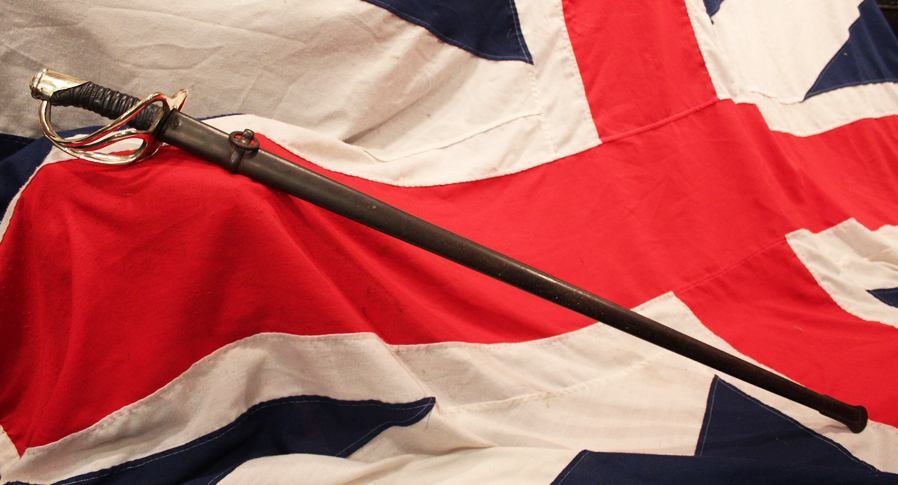A Simply Superb & Most Impressive Antique, Original French, Mid to Late 19th Century, Elite Cuirassiers, Heavy Cavalry Combat Sword
Typical Cuirassier double fullered 95 cm straight double fullered blade, arsenal engraved along the spine, Manf D'armes Du Chatl: Avril 1874 Cavalrie De Reserve Cuirassiers Mdl. 1854. Brass guard, somewhat of the Sabre de Cavalerie modele M1822 type, with replaced leather bound grip. Blade inspector stamped by Lt Col. Paul Charles Maldon & Francis Louis Sprenger
Much of the French heavy cavalry wore armoured cuirass and were armed with their straight swords, pistols and carbines. Though the armour could not protect against contemporary flintlock musket fire, it could deflect shots fired from long-range, stop ricochets and offer protection from all but very close range pistol fire. More importantly, in an age which saw cavalry used in large numbers, the breastplates (along with the helmets) provided excellent protection against the swords and lances of opposing cavalry and against infantry bayonets. It also had some psychological effect for the wearer (effectively making the cuirassier more willing to plunge into the thick of fighting) and the enemy (adding intimidation), while it also added weight to a charge, especially in cavalry versus cavalry actions.
Napoleonic French cuirasses were originally intended to be proof against three musket shots at close range; however, this was never achieved in practice. The regulations eventually recognised this, and cuirasses were subsequently only expected to be proof against one shot at long range. Dragoon regiments were not armoured.
The French cuirassiers numbered 11 regiments at the outbreak of war but had not seen active service since the Battle of Waterloo. A brigade comprising the 6th and 9th Regiments had served in the Crimean War but had not actually encountered the enemy. Accordingly, the prospect of action against the Prussian Army, in the Franco Prussian War which included 10 cuirassier regiments of its own, was seen as an opportunity for a strongly traditional branch of the French cavalry to prove its continuing relevance. In the event, in a series of massed charges against Prussian infantry and artillery at Froeschwiller and Rezonville, the French cuirassiers suffered very heavy losses for little return. To cover the French retreat General Michel's brigade of cavalry was ordered to charge. The order was somewhat vague, and in his position under cover near Eberbach, General Michel's had no knowledge of the actual situation. Thus it came about that, without reconnoitering or manoeuvering for position, the French cavalry rode straight at the first objective which offered itself, and struck the victorious Prussians as they were crossing the hills between the Albrechtsh userhof and Morsbronn. Hence the charge was costly and only partly successful. However, the Prussians were ridden down here and there, and their attention was sufficiently absorbed while the French infantry rallied for a fresh counterstroke. This was made about 13:20 h with the utmost gallantry. The Prussians were driven off the hillsides between the Albrechtsh userhof and Morsbronn which they had already won. But the counter-attack turned into disaster when 700 French cuirassiers were trapped inside Morsbronn and massacred within a few minutes by rapid close-range fire. The rest of the French cavalry eventually came under fire from the great artillery mass above Gunstett; von Bose having at length concentrated the main body of the XI corps in the meadows between the Niederwald and the Sauer, the French had to withdraw.
The story of the Cuirassiers at Reichshoffen displayes well the courage of the French cavalrymen. The French infantry withdrawal involved the retreat of the troops who had fought all day in defence of the Niederwald.
In desperation, MacMahon ordered General Michel's Cuirassier brigade (8th and 9th Cuirassiers) to attack the Prussians and buy his infantry the time they needed to fall back. Morsbronn and the flank of the Prussian XI Corps was to be the target of the charge.
Obediently Michel led his cuirassiers out of Eberbach where they had been held in reserve all morning. Sunlight glinted off polished cuirasses and helmets and harness jangled as the magnificent cavalry trotted off towards the south. As they emerged from the narrow Eberbach valley, Michel quickly lined up his squadrons and sounded the charge. Their swords drawn and horsetail crests streaming behind them, the cuirassiers thundered towards the Prussians. Suddenly the charging troopers were met not by a hail of bullets, but by hedged fields, fences, and trellised vineyards. The formation began to come apart. The various captains rallied their squadrons and continued the advance, but momentum had been lost. Now Prussian infantry opened on the French cavalry at point-blank range, and Krupps guns tore huge gaps in the charging ranks as horses and riders plunged and went down in writhing masses. A few squadrons actually reached Morsbronn where the Prussians blasted them from second story windows and trapped them in barricaded streets. Nine squadrons were shot to pieces.
No scabbard
Code: 20222
620.00 GBP










